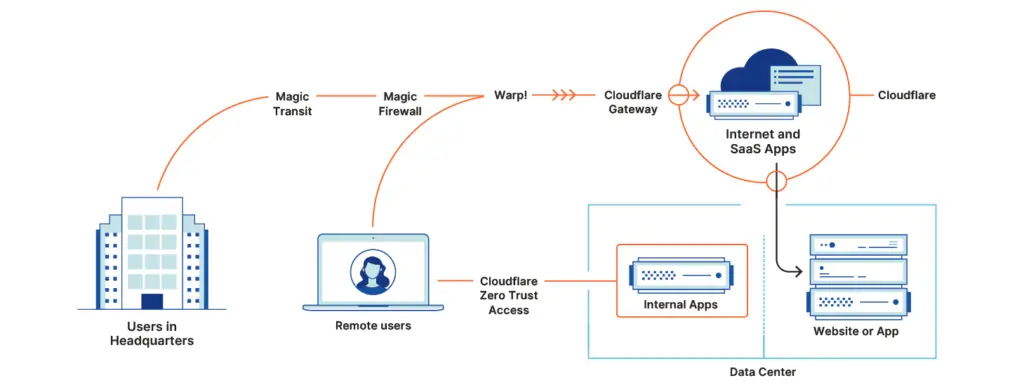The Importance Of Cloudflare In Web Infrastructure Security

Executive Summary

In today’s digital world, websites are constantly under attack. Cloudflare is a web infrastructure and security company that provides a variety of services to help protect websites from these attacks. Cloudflare’s services include:

- DDoS Protection: Cloudflare can help protect websites from DDoS attacks, which are attempts to overwhelm a website with so much traffic that it becomes unavailable.
- Web Application Firewall (WAF): Cloudflare’s WAF can help protect websites from malicious traffic, such as SQL injection attacks and cross-site scripting attacks.
- Content Delivery Network (CDN): Cloudflare’s CDN can help improve website performance by delivering content from servers that are located close to users.
- DNS Security: Cloudflare can help protect websites from DNS attacks, such as DNS cache poisoning and DNS hijacking.
- SSL Certificates: Cloudflare can help websites obtain and manage SSL certificates, which are used to encrypt traffic between a website and its users.
Cloudflare’s services are used by millions of websites around the world, including some of the largest and most popular websites on the Internet.
Introduction
Websites are under constant attack from a variety of threats, including DDoS attacks, malware, and phishing attacks. These threats can cause websites to crash, lose data, or even be taken offline. Cloudflare is a web infrastructure and security company that provides a variety of services to help protect websites from these threats. Cloudflare’s services are used by millions of websites around the world, including some of the largest and most popular websites on the Internet.
FAQs
What is Cloudflare?
Cloudflare is a web infrastructure and security company that provides a variety of services to help protect websites from DDoS attacks, malware, phishing attacks, and other threats.
How does Cloudflare work?
Cloudflare works by acting as a reverse proxy between a website and its users. When a user visits a website that uses Cloudflare’s services, their traffic is routed through Cloudflare’s network of servers. Cloudflare’s servers then check the traffic for malicious activity and block any traffic that is found to be malicious.
How much does Cloudflare cost?
Cloudflare offers a variety of pricing plans, starting at $0 per month. The cost of a Cloudflare plan depends on the number of features and services that are included in the plan.
DDoS Protection
What is a DDoS attack?
A DDoS attack is an attempt to overwhelm a website with so much traffic that it becomes unavailable. DDoS attacks can be launched from a variety of sources, including botnets, hacked computers, and even IoT devices.
How can Cloudflare protect against DDoS attacks?
Cloudflare protects against DDoS attacks by using a variety of techniques, including:
- Rate limiting: Cloudflare can limit the amount of traffic that is allowed to reach a website from a single source.
- Blacklisting: Cloudflare can blacklist malicious IP addresses and countries.
- DNS scrubbing: Cloudflare can scrub DNS records to remove malicious entries.
- Web application firewall: Cloudflare’s WAF can block malicious traffic at the application layer.
- DDoS mitigation: Cloudflare can mitigate DDoS attacks by absorbing and diverting malicious traffic.
Web Application Firewall (WAF)
What is a web application firewall?
A web application firewall (WAF) is a security device that is used to protect websites from malicious traffic. WAFs can block a variety of attacks, including:
- SQL injection attacks: SQL injection attacks are attempts to insert malicious SQL code into a website’s database.
- Cross-site scripting (XSS) attacks: XSS attacks are attempts to inject malicious scripts into a website’s code.
- Cross-site request forgery (CSRF) attacks: CSRF attacks are attempts to force a user to perform an unwanted action on a website.
- OWASP Top 10 threats: Cloudflare’s WAF can block the OWASP Top 10 threats, which are the most common web application vulnerabilities.
Content Delivery Network (CDN)
What is a content delivery network?
A content delivery network (CDN) is a network of servers that is used to deliver content to users from the server that is closest to them. CDNs can improve website performance by reducing latency and improving throughput.
How can Cloudflare improve website performance?
Cloudflare can improve website performance by:
- Caching static content: Cloudflare can cache static content, such as images and CSS files, on its servers. This can reduce the load on a website’s server and improve website performance.
- Optimizing content: Cloudflare can optimize content by compressing it and using lossless image compression. This can reduce the size of content and improve website performance.
- Routing traffic to the closest server: Cloudflare can route traffic to the server that is closest to a user. This can reduce latency and improve website performance.
- Load balancing: Cloudflare can load balance traffic across multiple servers. This can improve website performance by distributing the load and preventing any one server from becoming overloaded.
DNS Security
What is DNS security?
DNS security is the practice of protecting DNS from attacks. DNS attacks can include:
- DNS cache poisoning: DNS cache poisoning is an attack that involves poisoning a DNS cache with false information. This can cause users to be redirected to malicious websites.
- DNS hijacking: DNS hijacking is an attack that involves redirecting a domain name to a malicious IP address. This can cause users to be redirected to malicious websites or even lose access to a website.
How can Cloudflare protect against DNS attacks?
Cloudflare can protect against DNS attacks by:
- DNSSEC: Cloudflare supports DNSSEC, which is a protocol that is used to authenticate DNS records. DNSSEC can help to prevent DNS cache poisoning and DNS hijacking.
- **DN
